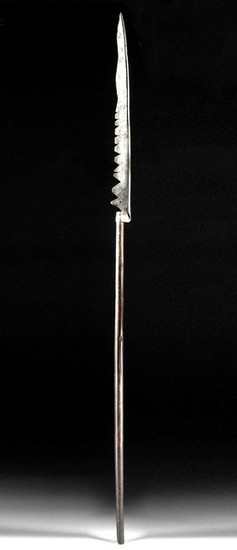17th C. German Steel Serrated War Scythe w/ Wooden Pole
Western Europe, Germany, ca. 17th century CE. A barbaric example of a forged-steel war scythe of an intimidating form. The elongated triangular blade head features a thick spine, a straight profile with a pointed tip, and an extremely sharp edge with several irregularly cut serrations. The loop-form butt end fits snugly around the top of a lengthy wooden haft and ensured that it would not fly off mid-swing. War scythes with serrated blades like this example denote that this was specifically meant as a weapon of war - mainly for hamstringing or dismembering moving horses - rather than a utilitarian instrument. Fine patina envelops both the scythe head and wooden haft, and a crown-shaped maker's mark on the scythe head denotes this was created at a German armory. Size: 88.9" L x 3.2" W (225.8 cm x 8.1 cm)
According to antique weapons expert and dealer Harvey J.S. Withers, "The war scythe was . . . an adapted agricultural scythe used for harvesting wheat. The main difference was that the war scythe had a less pronounced curve than its agricultural counterpart. Swung with sufficient momentum, the war scythe could literally cut a swathe through opponents." (Withers, Harvey J.S. "The Illustrated Encyclopedia of Swords and Sabres." Lorenz Books, London, 2010, p. 136.
Provenance: private J.H. collection, Beaverton, Oregon, USA, acquired January 2016; ex-Fagan Arms, Clinton Township, Michigan, USA
All items legal to buy/sell under U.S. Statute covering cultural patrimony Code 2600, CHAPTER 14, and are guaranteed to be as described or your money back.
A Certificate of Authenticity will accompany all winning bids.
We ship worldwide to most countries and handle all shipping in-house for your convenience.
#151962
Condition Report: Slight bending to overall form of blade head and some individual serrations, minor abrasions to blade, hafting ring, and pole, and light encrustations, otherwise intact and very good. Great patina throughout.
View it on
Estimate
Time, Location
Auction House
Western Europe, Germany, ca. 17th century CE. A barbaric example of a forged-steel war scythe of an intimidating form. The elongated triangular blade head features a thick spine, a straight profile with a pointed tip, and an extremely sharp edge with several irregularly cut serrations. The loop-form butt end fits snugly around the top of a lengthy wooden haft and ensured that it would not fly off mid-swing. War scythes with serrated blades like this example denote that this was specifically meant as a weapon of war - mainly for hamstringing or dismembering moving horses - rather than a utilitarian instrument. Fine patina envelops both the scythe head and wooden haft, and a crown-shaped maker's mark on the scythe head denotes this was created at a German armory. Size: 88.9" L x 3.2" W (225.8 cm x 8.1 cm)
According to antique weapons expert and dealer Harvey J.S. Withers, "The war scythe was . . . an adapted agricultural scythe used for harvesting wheat. The main difference was that the war scythe had a less pronounced curve than its agricultural counterpart. Swung with sufficient momentum, the war scythe could literally cut a swathe through opponents." (Withers, Harvey J.S. "The Illustrated Encyclopedia of Swords and Sabres." Lorenz Books, London, 2010, p. 136.
Provenance: private J.H. collection, Beaverton, Oregon, USA, acquired January 2016; ex-Fagan Arms, Clinton Township, Michigan, USA
All items legal to buy/sell under U.S. Statute covering cultural patrimony Code 2600, CHAPTER 14, and are guaranteed to be as described or your money back.
A Certificate of Authenticity will accompany all winning bids.
We ship worldwide to most countries and handle all shipping in-house for your convenience.
#151962
Condition Report: Slight bending to overall form of blade head and some individual serrations, minor abrasions to blade, hafting ring, and pole, and light encrustations, otherwise intact and very good. Great patina throughout.



